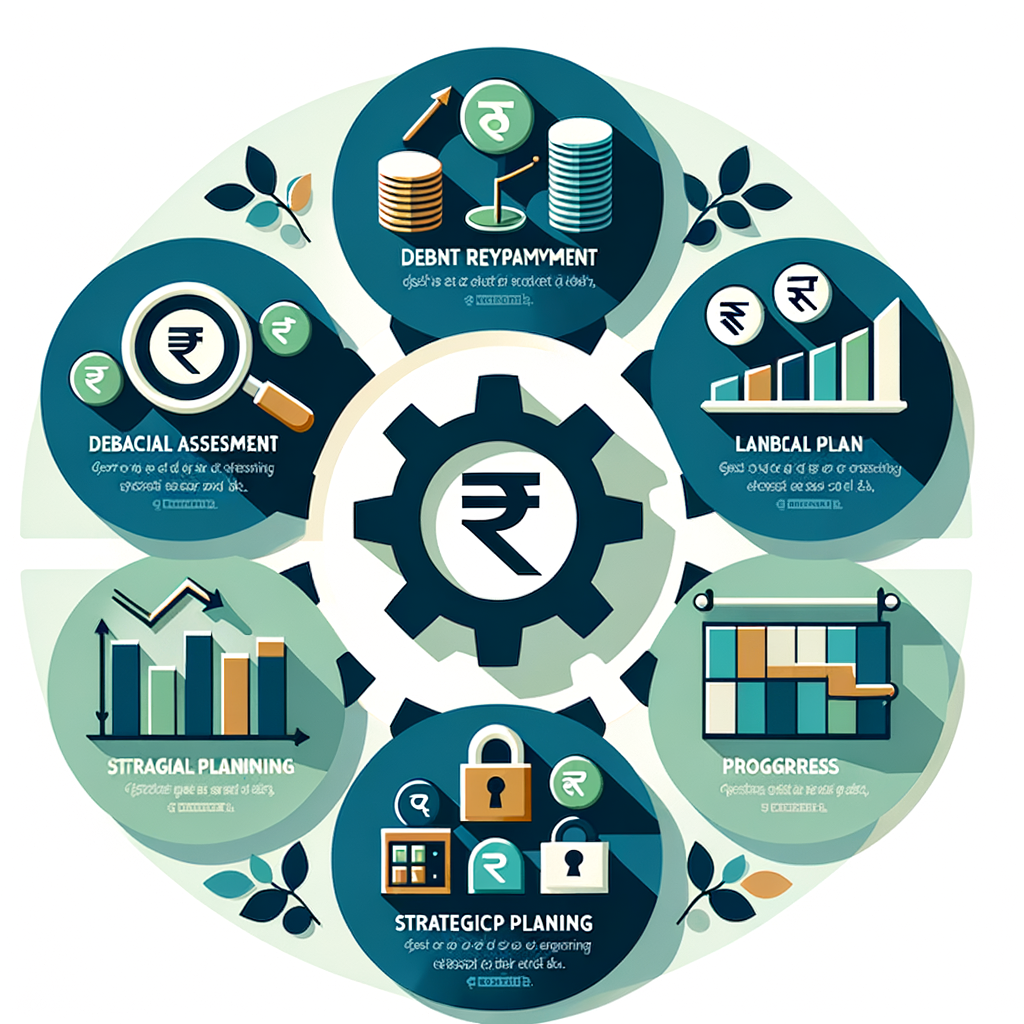Developing a Debt Repayment Plan That Really Works: A Guide for Indians
Juggling multiple EMIs is a familiar story for many Indians. The monthly payments for a credit card used for a recent vacation, a personal loan for a family wedding, and perhaps a small business loan can feel like a constant financial balancing act. This immense pressure, if left unmanaged, can lead to significant stress and anxiety. Creating a strategic debt repayment plan is the first and most critical step towards breaking free from this cycle and achieving lasting financial freedom. Without a structured approach, debt can quickly spiral out of control, damaging your CIBIL score, derailing long-term goals like buying a home or funding your child’s education, and taking a heavy toll on your mental well-being. This comprehensive guide covers everything you need to know about personal finance and debt repayment in India, offering actionable steps for both salaried individuals and small business owners to regain control of their financial future.
Why a Structured Debt Repayment Plan is Non-Negotiable in India
In the dynamic Indian economy, opportunities abound, but so do the avenues for accumulating debt. Simply earning more is not enough; managing what you owe with a clear strategy is paramount. A well-defined plan isn’t just a good idea—it’s an essential tool for financial survival and growth. It transforms a vague, stressful goal of “getting out of debt” into a series of manageable, achievable steps. This structured approach provides clarity, helps you track progress, and keeps you motivated on your journey to becoming debt-free. For many, it’s the difference between sinking under the weight of interest payments and building a secure financial foundation for the future, highlighting the urgent need for effective debt management solutions India.
The High Cost of Debt in India
The true cost of debt in India, especially unsecured debt, can be staggering. Credit card companies often charge interest rates that can range from 30% to as high as 45% annually. Personal loans, while cheaper, still carry significant interest rates, typically between 12% and 24%. The real danger lies in the power of compounding interest working against you. When you only make the minimum payment on a credit card, the interest for the month is calculated on the remaining principal, and the next month, interest is calculated on the new, larger principal. This cycle can trap you in debt for years, causing you to pay back several times the amount you originally borrowed. A structured plan forces you to pay more than the minimum, directly attacking the principal amount and drastically reducing the total interest you’ll pay over the loan’s lifetime.
Protecting Your CIBIL Score
In India’s credit landscape, your CIBIL score is your financial passport. This three-digit number, ranging from 300 to 900, is a summary of your credit history and is used by all lenders—from banks to NBFCs—to assess your creditworthiness. A high CIBIL score (typically 750 and above) is critical for securing future loans for a home, car, or business expansion at favourable interest rates. Even a single missed or late EMI payment can negatively impact your score, making future borrowing more difficult and expensive. A disciplined debt repayment plan ensures that all your payments are made on time, every time. This consistent positive behaviour is reported to the credit bureaus, gradually improving your CIBIL score and opening doors to better financial products in the future. This is a core part of Improving Your Credit Score Through Smart Debt Management. You can check your official score on the CIBIL website.
Achieving Financial Peace of Mind
The psychological burden of debt is often underestimated. Constantly worrying about making payments, avoiding calls from collection agencies, and feeling like you’re falling further behind can lead to chronic stress, anxiety, and even depression. This mental strain can affect your productivity at work, your relationships, and your overall quality of life. Implementing a clear debt repayment plan provides a powerful sense of control and direction. Knowing exactly what you owe, who you owe it to, and having a step-by-step strategy to pay it off brings immense psychological relief. Each debt you clear becomes a milestone, boosting your confidence and motivation. This roadmap to becoming debt-free replaces uncertainty with a tangible goal, allowing you to focus on your future rather than being trapped by your past financial decisions.
Step-by-Step: How to Create a Debt Repayment Plan in India
Creating an effective plan doesn’t require you to be a financial wizard. It requires honesty about your situation, discipline in your execution, and a clear, actionable framework. By following these four steps, you can build a robust plan that is tailored to your unique financial circumstances and goals. This systematic process will empower you to move from being overwhelmed by debt to proactively managing and eliminating it.
Step 1: Consolidate and Assess Your Debts
You cannot fight an enemy you don’t understand. The first step is to get a complete and unflinching view of your total debt. This means gathering all your loan statements, credit card bills, and any other records of money you owe. Create a master list or spreadsheet to organize this information clearly. This exercise gives you a comprehensive overview of your financial obligations and helps you identify which debts are costing you the most in interest. Be thorough and include everything, from formal bank loans to informal loans from friends or family. This clarity is the foundation upon which your entire repayment strategy will be built.
Here is a simple table format you can use:
| Lender Name (e.g., HDFC Bank, Bajaj Finserv) | Type of Debt (Credit Card, Personal Loan) | Total Amount Outstanding (₹) | Minimum Monthly Payment (₹) | Interest Rate (%) |
|---|---|---|---|---|
| ICICI Bank | Credit Card | ₹ 75,000 | ₹ 3,750 | 42.0% |
| Bajaj Finserv | Personal Loan | ₹ 2,50,000 | ₹ 8,100 | 18.5% |
| State Bank of India | Car Loan | ₹ 4,10,000 | ₹ 9,500 | 9.8% |
Crucially, sort this list from the highest interest rate to the lowest. This prioritization is key for the next steps.
Step 2: Create a Realistic Monthly Budget
Once you know where your money is owed, you need to understand where your money is going. Creating a monthly budget is non-negotiable. Track all your sources of income and categorize all your expenses for a month. A simple framework to start with is the 50/30/20 rule: allocate 50% of your income to Needs (rent/EMI, groceries, utilities, transport), 30% to Wants (dining out, entertainment, shopping), and 20% to Savings & Debt Repayment. Your goal is to find areas, particularly in the “Wants” category, where you can cut back to free up more cash. For salaried individuals, this could mean reducing online food orders, cancelling unused subscriptions, or opting for more affordable entertainment. For small business owners, it could involve scrutinizing operational costs, renegotiating with suppliers, or reducing non-essential overheads. The money you save should be directly channelled into your debt repayment fund. Mastering these steps is one of the most Effective Budgeting Techniques to Reduce and Eliminate Debt.
Step 3: Choose Your Debt Repayment Strategy
With a clear picture of your debts and a budget that frees up extra cash, you can now choose a strategy to attack your debt. The two most popular and effective methods are the Debt Avalanche and the Debt Snowball. Your choice will depend on whether you are motivated more by mathematical efficiency or by psychological wins. Both are powerful tools; the best one is the one you will consistently follow. These methods provide a systematic approach, ensuring every extra rupee you allocate is used with maximum impact.
- The Debt Avalanche Method: This is one of the most practical debt repayment strategies for professionals who are motivated by numbers. With this method, you continue to make minimum payments on all your debts, but you throw every extra rupee you have at the debt with the highest interest rate. Once that debt is completely paid off, you take the entire amount you were paying on it (minimum + extra) and “avalanche” it onto the debt with the next-highest interest rate. This process continues until all your debts are cleared. Mathematically, this method saves you the most money in total interest payments over time.
- The Debt Snowball Method: This method is often cited as one of the most effective debt repayment tips for salaried employees because it is built on momentum and motivation. Here, you focus on paying off the smallest debt first, regardless of its interest rate, while making minimum payments on the others. Once the smallest debt is gone, you “snowball” the payment you were making on it into the next-smallest debt. The psychological boost of clearing a debt completely, even a small one, provides a powerful “quick win” that can keep you motivated for the long haul.
Let’s compare using our example debts:
- Avalanche: You would focus all extra payments on the ICICI Credit Card (42%). Once paid off, you’d target the Bajaj Finserv Personal Loan (18.5%), and finally the SBI Car Loan (9.8%).
- Snowball: You would focus all extra payments on the ICICI Credit Card (₹75,000), as it’s the smallest debt. Once paid off, you’d target the Bajaj Finserv Personal Loan (₹2,50,000), and then the SBI Car Loan (₹4,10,000).
Step 4: Automate and Accelerate Your Payments
Consistency is the key to success. To avoid late payment fees and negative impacts on your CIBIL score, set up automatic payments (Auto-Debit/ECS/NACH) for at least the minimum monthly amount on all your debts. This creates a safety net. Then, based on your chosen strategy (Avalanche or Snowball), you must make an additional, manual payment towards your target debt each month with the extra cash you’ve allocated from your budget. Treat this extra payment with the same seriousness as a regular EMI. Furthermore, whenever you receive a financial windfall—such as an annual performance bonus, a festival bonus like Diwali, or a surge in business profits—resist the temptation to spend it. Instead, use a significant portion of it to make a lump-sum payment on your highest-interest debt. This can shave months or even years off your repayment timeline.
Top Tips for Debt Repayment in India: Tailored for Your Profile
While the core principles of debt repayment are universal, the specific tactics you can employ may differ based on whether you are a salaried individual or a small business owner. Understanding the tools and strategies available to your specific profile can significantly accelerate your journey to financial freedom.
Effective Debt Repayment Plans for Salaried Individuals
Salaried employees often have a predictable income stream, which can be leveraged to implement several effective strategies.
- Balance Transfers: If a significant portion of your debt is on a high-interest credit card, look for a balance transfer offer. Many banks offer new credit cards with a 0% or very low introductory Annual Percentage Rate (APR) for a period of 6-12 months. You can transfer your existing balance to this new card and focus on paying it off aggressively before the introductory period ends and the interest rate shoots up. Be mindful of the one-time processing fee, which is usually 1-3% of the transferred amount.
- PF Loan/Partial Withdrawal: This should be considered with extreme caution and often as a last resort. Under certain conditions specified by the Employees’ Provident Fund Organisation (EPFO), you can take a loan against or make a partial withdrawal from your PF balance for purposes like debt repayment. The major pro is that the interest rate on a PF loan is very low. The huge con is that you are borrowing from your future retirement corpus, which can have long-term negative consequences on your financial security.
- Negotiate with Lenders: Don’t be afraid to pick up the phone and talk to your bank or lender, especially if you have a good repayment history. You can often negotiate a lower interest rate on your personal loan or even convert outstanding credit card dues into a more manageable EMI with a lower interest rate. A single phone call could potentially save you thousands of rupees in interest.
Smart Debt Management for Small Business Owners
For small business owners, debt is often a necessary tool for growth, but it must be managed prudently. The line between personal and business finance can blur, making disciplined management even more critical.
- Improve Cash Flow: The lifeblood of any business is its cash flow. There are many Cash Flow Management Tips for Growing Businesses, but you should focus on strategies to improve it, such as implementing stricter credit terms for clients to accelerate invoice collection, optimizing inventory to reduce carrying costs, and managing your payables effectively. Increased cash flow means more available funds to service and pay down business debt faster.
- Refinance Business Loans: Periodically review your existing business loans. If your business has grown, has a better credit history, or if market interest rates have dropped, you may be eligible to refinance your high-interest business loan for a new one with a lower interest rate and more favourable terms. This can significantly reduce your monthly outflow.
- Separate Business and Personal Finances: This is a golden rule. Never use personal credit cards for business expenses or take personal loans to fund business operations. This complicates your accounting, makes it difficult to track business profitability, and puts your personal assets at risk. Maintain separate bank accounts, credit cards, and lines of credit for your business.
- Soft CTA: Navigating business debt can be complex. The experts at TaxRobo can help you analyze your finances and find the best
debt management solutions Indiafor your company.
Conclusion
Becoming debt-free is not a sprint; it’s a marathon that requires a clear roadmap and unwavering commitment. The journey begins with the decision to take control. By thoroughly assessing your debts, creating a realistic budget, choosing a powerful repayment strategy like the Debt Avalanche or Snowball, and staying consistent with your payments, you can systematically dismantle your debt and build a stronger financial foundation. Remember that every extra rupee paid towards your principal is a step towards freedom. With the right debt repayment plan, a goal that once seemed impossible becomes entirely achievable.
Ready to take control of your finances? Creating a personalized debt repayment plan is your first step. If you need expert guidance, TaxRobo’s financial advisors are here to help you navigate your journey to financial freedom. Contact us today for a consultation! This debt repayment guide for Indians is designed to empower you, but professional advice can provide a tailored strategy for your unique situation.
Frequently Asked Questions (FAQs)
FAQ 1: What is the fastest way to get out of debt in India?
Answer: There’s no single “fastest” way that fits everyone, but the most cost-effective method is the Debt Avalanche, as it saves the most money on interest. However, the truly best method is the one you can stick to consistently. The Debt Snowball’s motivational wins can make it “faster” for some people by keeping them engaged. To truly accelerate the process, combine your chosen strategy with aggressive actions like taking on a side hustle to increase your income or drastically cutting discretionary spending to free up more cash for repayments.
FAQ 2: Will a debt repayment plan hurt my CIBIL score?
Answer: On the contrary, a disciplined debt repayment plan is one of the best ways to improve your CIBIL score. By making consistent, on-time payments, you are demonstrating responsible credit behaviour, which is the most important factor in your score calculation. As you pay down your balances, your credit utilization ratio decreases, which also positively impacts your score. One word of caution: avoid closing old credit card accounts as soon as you pay them off. The age of your credit history is a factor, so keeping them open with a zero balance is often beneficial.
FAQ 3: Should I consider a debt consolidation loan?
Answer: A debt consolidation loan—taking out a single new loan to pay off multiple existing ones—can be a good option, but only if you can secure a new loan with a lower interest rate than the weighted average rate of your current debts. It simplifies your finances into a single EMI, making it easier to manage. However, it’s crucial to read the fine print on the new loan’s terms and fees. Most importantly, a consolidation loan is a tool, not a cure. You must commit to not accumulating new debt, or you’ll end up in a worse position.
FAQ 4: How much extra should I pay towards my debt each month?
Answer: There’s no magic number, but the principle is simple: pay as much as you possibly can. After you’ve created your budget, covered all your essential needs (the 50%), and perhaps set aside a very small amount for an emergency fund, you should allocate the maximum possible portion of your remaining income towards your targeted debt. Even an extra ₹1,000 – ₹2,000 per month can make a substantial difference, significantly reducing your repayment timeline and the total interest you pay over the life of the loan.



